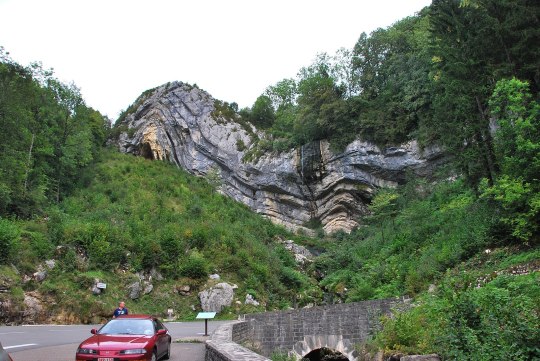#J. Batenburg
Explore tagged Tumblr posts
Text

J. Batenburg / MI / Brutalist Sideboard / Furniture / 1969
1 note
·
View note
Text

BRUTALIST CABINET IN BLACK STAINED OAK BY J. BATENBURG FOR MI, BELGIUM CA. 1969.
51 notes
·
View notes
Text

J. BATENBURG
3 notes
·
View notes
Text
Folded Forest: Defining the Jurassic Period
by Jane Thaler
What’s in a Name?
Derived from the words for “middle life” in Greek, the Mesozoic Era consisted of three geological periods: the Triassic, Jurassic, and Cretaceous. While many of us might be aware of all three, the term “Jurassic” has seeped into our everyday lives in a way that the Triassic and Cretaceous have not. We can attribute much of this ubiquity to the wildly popular Jurassic Park books by Michael Crichton and their subsequent film adaptations, but have you ever wondered what “Jurassic” actually means and how scientists define the period’s geological boundaries?
Coining “Jurassic”
The “Jura” in Jurassic refers to the Jura Mountains that run along a large portion of the Swiss and French border. Named for the ancient Celtic word for forest, the Jura Mountains are known for their tree-covered peaks and the folded rocks that comprise them (Jones, 2020, p. 94).

Jura Mountains from Wikimedia Commons.
It was here in 1795 that Alexander von Humboldt, a Prussian explorer and naturalist, documented a series of carbonate shelf deposits from the period now known as the Jurassic and dubbed them the “Jura Kalstein.” Alexander Brongniart, a French scientist known for arranging and describing the geologic formations of the Tertiary Period (66.0 to 2.6 million years ago), coined the term “Terrains Jurassiques” to refer to all Jurassic strata in 1829. In 1832, German geologist Leopold von Buch established the three-fold subdivision of epochs based on the folds of limestone in the Jura: the Lias (Early Jurassic), the Dogger (Middle Jurassic), and the Malm (Late Jurassic). This arrangement remains the basic framework for our geological understanding of the Jurassic to this day (Ogg et al., 2012b, p. 732; Encyclopedia Britannica, 2021a).

Jura Mountain fold known as the “Chapeau de Gendarme” from Wikimedia Commons.
Beginning of the Jurassic
Nestled between the Triassic and Cretaceous periods, the Jurassic spanned from 201.3 million years ago to 145 million years ago (National Park Service, 2020). The end of the Triassic (so named because it is a group of three strata) and the beginning of the Jurassic is marked by the Triassic–Jurassic (Tr–J) extinction event, sometimes called the end-Triassic extinction. The fourth of five major extinction episodes on Earth (or sixth if you count the current, anthropogenic extinction), the Tr–J extinction wiped out around 75 percent of all marine and terrestrial life (Encyclopedia Britannica, 2021b).
Current evidence suggests that the Tr–J extinction was initially set into motion by movements of the Earth’s crust. As the all-encompassing mega-continent Pangea began to break apart, the associated tectonic shifts caused significant volcanic activity that spewed carbon dioxide into the atmosphere. The resulting global warming disrupted the Earth’s carbon cycle and contributed to ocean acidification (Fuge, 2020).
The ecological niches left open by the Tr–J extinction were quickly filled by remaining species of pterosaurs, crocodilians, turtles, mammals, many species of plants and invertebrates, marine life, and dinosaurs. Though many species died out during the extinction event, the wet and warm climate of the Jurassic in many places encouraged the growth of lush vegetation along with the proliferation and diversification of fauna. Oceans teemed with life, forests flourished, and dinosaurs became the dominant forms of backboned animal life on land during this time (Encyclopedia Britannica, 2021b).

Jurassic landscape in the Dinosaurs in Their Time exhibition at Carnegie Museum of Natural History.
End of the Jurassic
The end of the Jurassic is a bit of a mystery as the geological boundary between it and the Cretaceous Period (the latter name derived from the Latin for “chalk”) remains formally undefined. In fact, the Cretaceous is the only period in the Phanerozoic Eon (541 million years ago to present day) that “does not yet have an accepted global boundary definition” (Ogg et al., 2012a, p. 795). This definitional challenge is due to a number of factors but is mostly attributed to the concept of provincialism or provinciality, which means that plant or animal populations were restricted to a particular area or group of areas (Gale et al., 2020). This resulted in endemic populations, particularly of ammonites, which left uneven or unclear fossil markers in the stratigraphic record (Wimbledon, 2017; see Énay, 2019 for more detail on the J/K boundary debates).
We do know that the end of the Jurassic was marked by the Tithonian–early Barremian cool interval, which began 150 million years ago and continued well into the Early Cretaceous (Ogg et al., 2012a). During this time, some groups of animals did go extinct or become less diverse, like the dinosaurian subgroup Stegosauria that included Stegosaurus, while others increased in abundance, like some ammonite subgroups who survived the Tr–J event. Plants were also developing in important ways during this time. Around 130 million years ago, angiosperms (flowering plants) began to diversify, and they became increasingly dominant throughout the Cretaceous (Friis et al., 2010). Taking the unknowns and variables into account, the end of the Jurassic is currently placed at 145 million years ago.
Naming Geological Periods
Many of the names we still use for geological periods went through a similar process to that of the Jurassic: a scientist named a phenomenon based on the strata they were studying and the nomenclature (the system of names) developed from there. Nowadays, defining and naming geological units is left to the International Commission on Stratigraphy of the International Union of Geological Sciences. The process by which this happens feels about as long as the geologic periods themselves, at least to those of us watching from outside the commission. This is, of course, an exaggeration, but it does take years of work and rounds of voting to arrive at an official stratigraphic boundary designation.
Check out https://stratigraphy.org for the latest updates on humanity’s understanding of geologic time.
Jane Thaler is a Gallery Experience Presenter and Floor Captain in CMNH’s LifeLong Learning Department. Museum staff, volunteers, and interns are encouraged to blog about their unique experiences and knowledge gained from working at the museum.
References:
enay, Raymond (2019). The Jurassic/Cretaceous System Boundary is at an impasse: Why not go back to Oppel’s 1865 original and historic definition of the Tithonian? Cretaceous Research. https://doi.org/10.1016/j.cretres.2019.104241.
Encyclopedia Britannica (2021a). Alexandre Brongniart. https://www.britannica.com/biography/Alexandre-Brongniart
Encyclopedia Britannica (2021b). End-Triassic extinction. https://academic-eb-com.pitt.idm.oclc.org/levels/collegiate/article/end-Triassic-extinction/474417
Fuge, L. (2020). Volcano link to end of Triassic extinction. Cosmos. https://cosmosmagazine.com/history/palaeontology/volcano-link-to-end-of-triassic-extinction/
Friis E. M., Pedersen K. R., Crane P. R. (2010). Diversity in obscurity: fossil flowers and the early history of angiosperms. Philosophical Transactions of the Royal Society B, 365. https://doi.org/10.1098/rstb.2009.0227
Gale, A. S., Mutterlose, J., Batenburg, S., Gradstein, F. M., Agterberg, F. P., Ogg, J. G., Petrizzo, M. R. (2020). The Cretaceous Period. In The Geologic Time Scale 2020 (Gradstein, F. M., Ogg, J. G., Schmitz, M. D., & Ogg, G. M., Eds.). Elsevier. https://doi.org/10.1016/B978-0-12-824360-2.00027-9
Gore, R. (n.d.), The rise of mammals. In National Geographic. https://www.nationalgeographic.com/science/article/rise-mammals
Ogg, J. G., Hinnov, L. A., Huang, C. (2012a). Cretaceous. In The Geologic Time Scale 2012 (Gradstein, F. M., Ogg, J. G., Schmitz, M. D., & Ogg, G. M., Eds.). Elsevier.
Ogg, J. G., Hinnov, L. A., Huang, C. (2012b). Jurassic. In The Geologic Time Scale 2012 (Gradstein, F. M., Ogg, J. G., Schmitz, M. D., & Ogg, G. M., Eds.). Elsevier.
Jones, P. (2020). Jura Mountains, France/Switzerland. In Around the World in 80 Words. University of Chicago Press. https://doi.org/10.7208/9780226682822-026
National Park Service (2020). Geologic time scale. https://www.nps.gov/subjects/geology/time-scale.htm
Pfiffner, O. A. (2006). Thick-skinned and thin-skinned styles of continental contraction. Special Paper of the Geological Society of America, 414.
Sauquet, H., von Balthazar, M., Magallón, S. et al. (2017). The ancestral flower of angiosperms and its early diversification. Nature Communications, 8. https://doi.org/10.1038/ncomms16047
Scotese, C. R., Song, H., Mills, B. J. W., van der Meer, D. G. (2021). Phanerozoic paleotemperatures: the Earth’s changing climate during the last 540 million years. Earth-Science Reviews, 215. https://doi.org/10.1016/j.earscirev.2021.103503
Wimbledon, W. A. P. (2017). Developments with fixing a Tithonian/Berriasian (J/K) boundary. Volumina Jurassica, XV. https://doi.org/10.5604/01.3001.0010.7467
31 notes
·
View notes
Text
The Impact Social Media has on Society. Considering Race, Gender, Class, and Other Demographic Factors.
Social media has become so common that it is part of everyday live. People are choosing to get information, and content from social media platforms versus traditional media outlets. Television news broadcast, newspapers, and radio has become things of the past (to a certain extent). Social media has given numerous individuals of social groups a platform to express narratives, opinions, facts, truths, and perspectives. This has given a certain power to these social groups that at times challenges major media outlets, organizations, and corporations.
One impact that social media is used professionally is advertising. Social media platform itself can be considered advertising. Individuals socially connect with others by posting certain images to receive some kind of attention for a outcome. This is done professionally by connecting with work colleges, clients, associates, and fans more on a business personal level. This is effective because people can get a closer understanding of the business practices, policies, products, services, goals, and purposes of the business. This factor helps people to identify, relate, and understand the character of the business and/or their personnel. Race, gender, and other demographics plays a role in this, because the businesses can reach out across these differences and connect to these individuals of these social groups. This is done by respecting, addressing, and giving attention to the problems, challenges, and awareness to social groups, without promoting their products or services. “Consumers believe that companies should take action to improve social and environmental issues that may not be relevant to their business operations (Cone Inc., 2017). To take responsibility, many companies have established sustainability disciplines (Aguilera et al., 2007) and disclosed their efforts through different communication channels (Leonidou et al., 2011; McNeill and Moore, 2015)” (Kyeongwon & Jaejin).
Social media is used personally to connect with family, friends, acquaintances, and meeting new people. Social media is used to give and receive attention from individuals that we have personal connections with, and have social agendas with. This good consists of: organization family/friends functions, social gatherings, fundraisers, support, information, and etc. This platform is used to check up on people that we don’t necessarily communicate on a everyday basis, but occasionally.
The differences of communication professionally and personally is almost opposites of each other. Professionally on social media, individuals usually use their real names on their platforms. Personally, individuals tend to use more nicknames, shorten their names, or use initials. Another difference between professional versus personal on social media, is profile pictures, and pictures/images in general. Professional people usually have presentable images that are safe, not to challenging, or anything that might negatively effect the status and image of the person and company. “Respondents rated the individual on ‘likability’ and ‘respect’. Results indicated that integrating personal and professional contacts yields higher levels of likability than segmenting them. Posting self-enhancing messages results in higher levels of respect than posting self-verifying messages. Findings imply that the best strategy to preserve respect and likability among colleagues is to integrate professional contacts on Facebook and post self-enhancing messages (so called ‘content’ behavior)” (Batenburg & Bartels).
Batenburg, A. & Bartels, J. Keeping up online appearances: How self-disclosure on Facebook affects perceived respect and likability in the professional context.
Kyeongwon, K. & Jaejin, L. Corporate social responsibility advertising in social media: a content analysis of the fashion industry’s CSR advertising on Instagram
1 note
·
View note